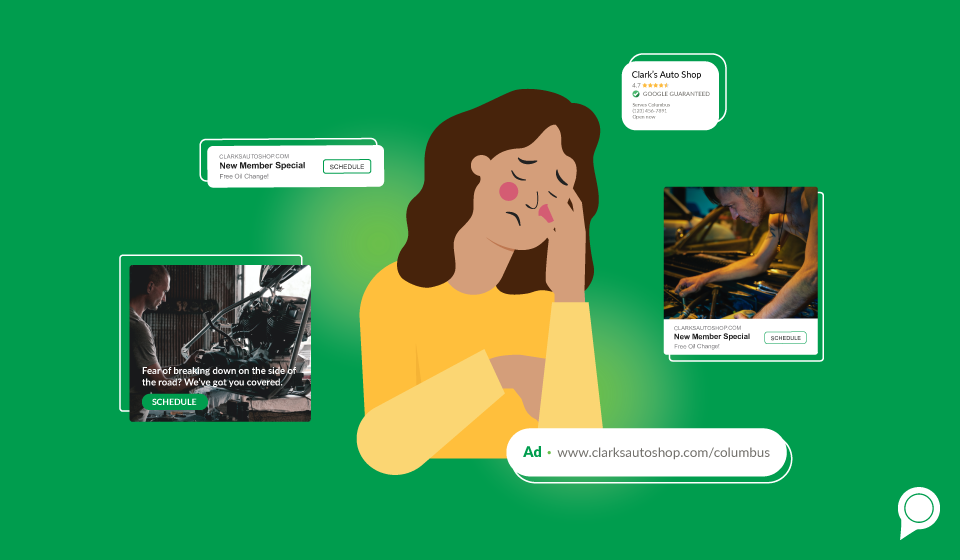

Paid advertising campaigns are effective lead generation strategies. Knowing how to best leverage and support your paid ad campaigns to keep them working for you is important, but knowing what not to do can be equally impactful. One pitfall to avoid when running paid ad campaigns is risking ad fatigue, or ad burnout.
Ad fatigue is a phenomenon that happens when an ad has been over-served to a particular audience or individual and it loses its effectiveness as a result. It’s no longer compelling to the target market.
Ad fatigue is a tricky thing to avoid and takes careful attention to your paid ad campaigns. In this blog, we’re going over everything you can do to keep your paid ads fresh and your target audience free from burn out.
Refreshing and updating your ad creative is a case-by-case decision. If you have evergreen campaigns running, consider updating the copy, video or graphic content once a quarter or every six months. Paid ad campaigns that are shorter and more specific in scope may not need refreshed during their run!
Time really is the biggest deciding factor when it comes to avoiding ad burnout. However, before randomly scheduling periodic ad creative updates, make sure to check the ads performance. Maybe the ad is strong and brings in quality leads even after it’s been running for several months. In that case, the ad hasn’t reached its “fatigue level” yet and is still working for your business.
If you check in on a campaign and some of the ads are meeting KPIs but some aren't, consider refreshing a portion of the ads only after you’ve explored and rectified other reasons why the ads might be falling behind.
Having a schedule where you at least check in on ad creative is a good practice, even if you don’t decide to change anything in those checkups. If the creative feels or looks outdated or tired to you, that’s a good indication it’s time for a change. But if the ad still has a spark, let it do its work!
A|B tests help hold off ad fatigue because there are different versions of the same ad being served to the same audience: a user might be served one version of the ad, but later in the week be served the other version and not necessarily know that the two were connected.
You can run A|B tests several different ways to combat ad fatigue. Even if you’re serving ads to two totally different audiences, consider making some of the ads in each group different colors or using slightly different phrasing. You can turn one ad set off then start the other one so the two don’t overlap. However you choose to run your A|B test, you will learn more about what resonates with your target audience as well as keeping your ads effective longer.
Dynamic ads are designed to optimize over time. Dynamic ads give the advertiser several headlines, descriptions, images, and CTAs to input when creating the ad. Over time, the ad platform mixes and matches the various assets provided to produce the most compelling ad.
Using dynamic ads is a great way to automate fending off ad burnout. Because the ad being served is constantly changing, the audience doesn’t have the opportunity to become “ad blind” since there’s something new for them to engage with every time. However, once the platform decides on the best asset combination, that’s when you’ll need to start monitoring your ads performance and timeline for signs of ad and creative fatigue.
This doesn’t mean advertising to online users who are obviously out of your market and who have never seen one of your ads before.
If you typically target a certain audience at a particular age range, explore how you can alter the age range and create an ad that speaks directly to them! They still have the problems your business solves, but they might not have been your company’s focus. Create ads that are more focused on women than men and vice versa, shrink or enlarge the geographic region of your ads…etc!
It’s important here to not sacrifice your ideal customer persona and send your ads to people who may not need what you have to offer. The key is to find little changes you can make that can lengthen the effectiveness of your ad while getting your business in front of new and quality leads.
Google Ads and Meta Ads both have a tool called a frequency cap. It’s a tool designed to limit how often an ad is served.
This tool is useful to postpone ad fatigue and also make use of your budget more effectively. If your audience is burnt out on your business’s ads, they won’t convert, and you won’t get the leads you want. Showing your ads less frequently is also often more strategic as it means you can run the campaign longer on your budget and not run into ad fatigue! Longer campaign run times mean more brand exposure and awareness for your target audience and more qualified leads down the road.
Frequency capping helps all of these strategies and makes your ads work longer for your business.
Remember to use data when determining if you need to take action to refresh your paid ads campaigns! Just because you might be tired of seeing the same ad doesn’t necessarily mean your audience is. Staying in tune with your campaign’s KPIs and the latest ad design trends can help you make informed decisions that will benefit your paid ad strategy and business in the long run.
RevLocal is a full service digital marketing agency and we specialize in creating personalized online paid advertising campaigns for small business and franchise brands. If you’re new to paid ads, or digital marketing in general, contact us for a free consultation on how we can help your business grow!
Subscribe to our email list to get the latest digital marketing content delivered to your inbox each week!